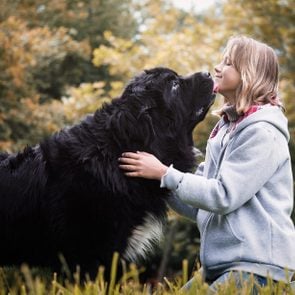Are Pit Bulls Dangerous? Experts Set the Record Straight on These Lovable Dogs
Updated: Apr. 23, 2024

These lovable dogs get a bad rap, but are pit bulls dangerous? Veterinarians and canine behaviorists set the record straight, once and for all, on this much-maligned dog.
If you’ve ever been lucky enough to love and be loved by a pit bull, then you know they’re special dogs, and one of the most popular dogs in the country. Recognized by their square faces, broad chests and muscular builds, these dogs may look intimidating, but behind that facade, you’ll find they’re lovable, charming and playful goofballs—and some of the most loyal and affectionate dogs around. However, as you’re probably well aware, pit bulls aren’t always associated with family-friendly qualities. They’re often thought of as aggressive, vicious and untrainable, and chances are, you’ve heard more than a few concerning pit bull “facts.” Some cities have even banned pit bulls in an attempt to decrease the number of dog attacks. But are pit bulls dangerous?
While it is true that pit bulls have a violent past—their ancestors were bred to fight bears in British blood sports, and far too many are still used in illegal dog fights—that doesn’t define them today. As any trainer will tell you, a dog’s upbringing will determine its temperament far better than its breed, and many experts have gone to bat to protect these pups. Because of that, some cities have even reversed their pit-bull bans. Denver, for example, repealed its ban in 2021, and many other cities have followed suit.
To dispel common pit bull myths, we spoke with several veterinarians and animal behaviorists and combed through recent studies and position papers. Ahead, we’re setting the record straight on pit bull myths. Maybe a bully breed will be your four-legged companion in the near future.
Get Reader’s Digest’s Read Up newsletter for more cleaning, humor, travel, tech and fun facts all week long.
About the experts
Reviewed for accuracy by: Wailani Sung, MS, PhD, DVM, DACVB, a board-certified veterinary behaviorist who provides behavioral consultations at the Behavior Specialty Clinic located at the San Francisco SPCA. |
Are pit bulls dangerous?
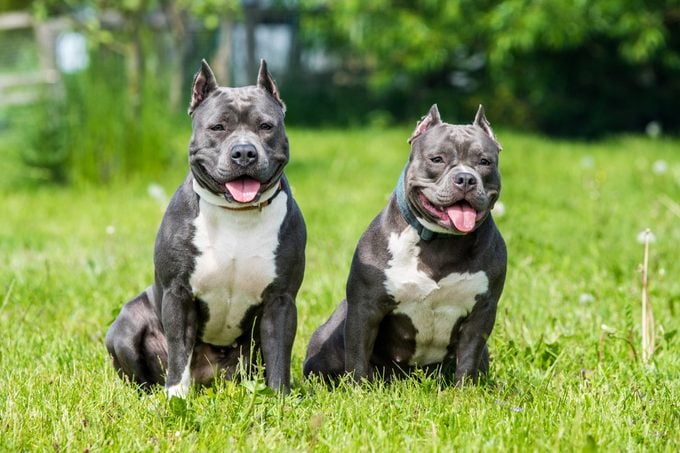
“There are no dogs that are inherently vicious,” says Melissa Pezzuto, behavior consultant team lead at Best Friends Animal Sanctuary in Kanab, Utah, which famously rehabilitated the pit bulls rescued from Michael Vick’s notorious dog-fighting ring. “Viciousness and aggression are not breed characteristics or personality traits, and they are not specific to any one breed of dog.” A dog’s life experiences, such as abuse and lack of socialization, are factors that can lead to viciousness, not a specific breed of dog.
Pezzuto points to the results of a national program of temperament testing for dogs. In the American Temperament Test Society rankings on dog temperament, which looks at signs of panic, avoidance and aggression, the two breeds often associated with pit bulls, the Staffordshire bull terrier and the American pit bull terrier, earned high marks for affability, with scores of 90.9% and 87.4%, respectively. That means they were less likely to show aggression than many traditional “family dogs,” including the beagle (79.7%), golden retriever (85.6%) and St. Bernard (84.9%).
How common are pit bull attacks?
There is no nationwide reporting system for tracking dog bites today. In fact, the U.S. Centers for Disease Control and Prevention (CDC) stopped collecting breed data on dog-bite-related fatalities in 1998. It is worth noting that a recent study published in International Journal of Pediatric Otorhinolaryngology (IJPO), which looked at dog-bite data from the University of Virginia Health System and Nationwide Children’s Hospital from 240 patients over the last 15 years, found that “injuries from pit bulls and mixed-breed dogs were both more frequent and more severe.”
But in defense of pit bulls and their brethren, the data set for the IJPO study was small and only includes injuries that required an ER visit or other medical treatment. So while pit bulls and similar breeds with large heads and jaws may be capable of inflicting a more severe bite, there are countless unreported dog bites from just as many breeds, sizes and shapes of dogs. Lesa Staubus, DVM, a former veterinarian with the American Humane Rescue, adds that there are several factors related to lethal dog bites, including the absence of owner supervision, unneutered dogs and dogs that were isolated with little positive human interaction, as well as “owner history of mismanagement, abuse and/or neglect.”
| American Pit Bull Terrier | |
| Breed overview | |
| Height: | 17 to 19 inches |
| Weight: | 40 to 70 pounds |
| Life expectancy: | 12 to 16 years |
| American Staffordshire Terrier | |
| Breed overview | |
| Height: | 17 to 19 inches |
| Weight: | 40 to 70 pounds |
| Life expectancy: | 12 to 16 years |
| Staffordshire Bull Terrier | |
| Breed overview | |
| Height: | 14 to 15 inches |
| Weight: | 23 to 38 pounds |
| Life expectancy: | 12 to 14 years |
Myths about pit bulls
Pit bulls tend to be misunderstood. With false information aplenty about pit bull–type dogs, it’s important to sift through the misconceptions and find the truth. To help, dog behaviorists and vets alike tackle the most common pit bull myths here.
Myth: Pit bulls are purebreds

Truth:
A dog with a blocky head, almond eyes, broad chest, muscular build and short hair must be a pit bull, right? Nope. There is no definitive answer when it comes to what constitutes a pit bull, but they are descendants of the English bull-baiting dog. The American Kennel Club (AKC) doesn’t even recognize pit bulls as a specific breed. “Breeds often labeled as pit bulls are actually individual and distinct breeds, such as the Staffordshire Bull Terrier, American Pit Bull Terrier, American Bully, American Staffordshire Terrier and the American Bulldog,” says Colleen Demling-Riley, a canine behaviorist with Pawtopia. Riley points to one study that revealed even veterinarians, breeders and trainers often guess the wrong breed or mix when looking at a dog.
Myth: Pit bulls are a fighting breed
Truth:
Pit bulls are distant relatives of English bull-baiting dogs, which were “bred to bite and hold bulls, bears and other large animals around the face and head,” per the ASPCA’s Position Statement on Pit Bulls. When baiting large animals was outlawed in the 1800s, the English bull-baiting dogs were bred with smaller terriers to produce a fighting breed. In the ASPCA’s statement, they point out that while some pit bulls may have been bred to fight against other dogs, “it doesn’t mean that they can’t be around other dogs or that they’re unpredictably aggressive.”
The statement goes on to explain that many pit bulls who attacked their owners or other people were put down, ending their bloodline. On the other hand, many pit bulls were bred for companionship and are known to be gentle, affectionate and loyal. Today’s pit bulls are likely a mix of the two, and “the result of random breeding is a population of dogs with a wide range of behavioral predispositions,” the statement says.
Myth: Pit bulls don’t get along with other pets

Truth:
Just like humans, dogs can have people they are more comfortable and social with—and it’s not breed specific. And while there are pet combos that don’t mix, every dog is different. “Each dog is an individual, and their response to other animals will be dependent on their development and things such as their individual disposition, socialization and previous experiences,” says Megan Stanley, owner of Dogma training and pet services. Her late, great pit bull, Duke, helped at her training facility to socialize puppies and dogs with limited social skills. “He was a wonderful mentor dog for helping fearful dogs gain confidence, exposing puppies to large dogs, and helping dogs gain social skills so they could integrate back with their human companions,” she explains. At home, Duke lived in harmony with two other dogs and a cat.
Myth: Pit bulls turn on you in an instant
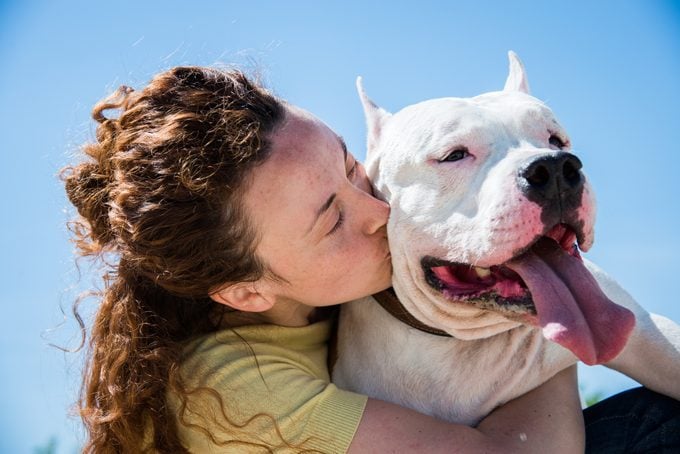
Truth:
According to Pezzuto, dogs of any breed rarely turn on people without warning signs. In fact, your dog’s tail could be trying to tell you. “Dogs give us many subtle signals that they are uncomfortable, including lowered bodies, tucked tails, snarling or growling,” she explains. “Instead of listening to this communication, we often ignore or even reprimand our dogs for doing so. This results in the dog suppressing the warning signals and possibly jumping to snapping or biting the next time they are uncomfortable.”
Myth: Pit bulls are dangerous because they are on a BSL list
Truth:
Breed Specific Legislation (BSL) is a term for laws that regulate or ban certain dog breeds to decrease dog attacks on humans and other animals. The ASPCA actually calls this breed-discriminatory. The AKC, Humane Society, American Bar Association and many other organizations oppose BSL, and 18 states have legislation that prohibits it. The American Veterinary Society of Animal Behavior says, “BSL is ineffective and can lead to a false sense of community safety as well as welfare concerns for dogs identified (often incorrectly) as belonging to specific breeds.” The false sense of security relates to people thinking a specific breed is safer over another breed, when all dogs are capable of biting. “BSL is the result of misunderstanding and prejudice against these blocky-headed dogs.”
Myth: BSL decreases dog attacks
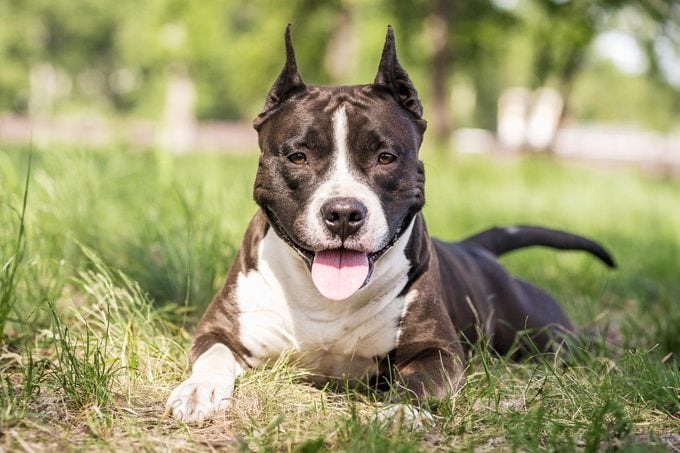
Truth:
Unfortunately, while more than 700 U.S. cities have enacted BSL, there’s no evidence these laws work, according to the ASPCA. “In eight of the countries that have breed bans, they’ve studied whether or not they actually reduce dog bites and serious bite injuries, and they’ve found that they do not,” says the ASPCA’s position statement on breed-specific laws. It also cites a number of flaws in the BSL approach. Among them: soaring shelter euthanasia rates among pit bills and other banned breeds that have been seized, diversion of animal control funds and resources that could be better spent on safety, education and animal welfare efforts, and an increase in underground, illegal activity, especially dog-fighting around banned breeds.
Myth: There are so many pit bulls in shelters because they can’t be trusted
Truth:
“The reasons why pit bull types end up in shelters are no different than the reasons why every other breed winds up in shelters,” says Stephen DeBono, a dog training and behavior specialist. Dogs end up in shelters for a variety of reasons. They may have caused trouble with another pet, bit someone, were too aggressive or had too much energy. In some cases, owners didn’t have time to care for the dog or they passed away or moved. “These reasons are true of pit bull types, Chihuahuas, Labrador retrievers, German shepherds and every other breed,” says DeBono. Stanley adds that BSL is a huge factor too, as pet parents may have to surrender their pit bull if they move to a city, county or specific apartment, condo or HOA that bans them.
Myth: Pit bulls are impossible to train
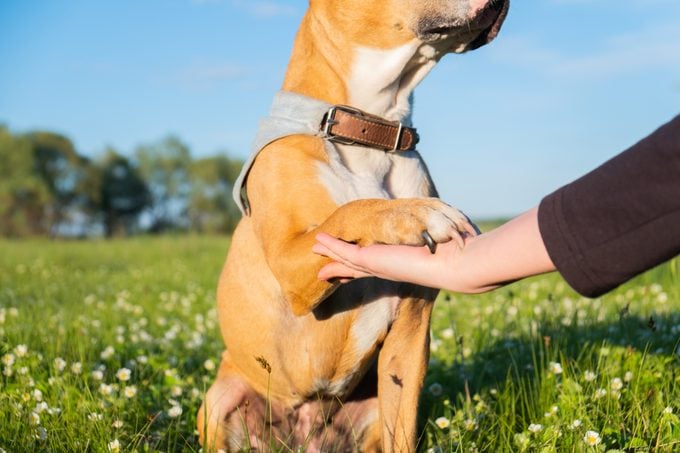
Truth:
Because of pit bulls’ sheer size and strength, you’ll want to enroll them in dog obedience training school ASAP. And when you do, you can expect them to excel. “The breed’s intelligence and desire to please make training a fun, easy process,” writes the AKC specifically about the American Staffordshire Terrier. The experts note that the dogs are especially talented at canine sports, including obedience, agility and dock diving.
Several pit bulls have risen to fame due to their obedience and skill, meaning this “pit bull fact” is a verifiable myth. Sergeant Stubby, for example, a dog that served on the Western Front in World War I with the 102nd Infantry Regiment, is America’s most decorated war dog. He participated in four offensives and 17 battles, making him one of the bravest dogs in history. Then there’s Darby, the hero pit bull who saved his owner from a shark attack!
Pit bull FAQs
Are pit bulls good family dogs?
Like any dog, pit bulls need to be trained to be in a home with children and to react appropriately to any children they may encounter inside or outside the house. They pass the American Temperament Test Society’s exam with flying colors and can make very loyal, loving family pets. But like any other breed, they shouldn’t be left unsupervised with toddlers or young children. Kids, too, may need some “obedience training” in terms of how to interact with their new canine sibling.
What should you know before owning a pit bull?

Even the most devout pit bull lover will caution you to be prepared for a pup that needs a lot of exercise, attention and affection. Miami Valley Pit Crew, an Ohio pitty rescue group, shares that pit bulls are bundles of energy until at least the age of 5, and the group recommends “daily running, climbing, agility, weight pulling, tire swinging, hiking” and any kind of strenuous activity to drain your pit bull’s energy. They also recommend socializing your dog with other dogs early on, crate-training to ease separation anxiety and being consistent and firm (but loving) when it comes to enforcing behavioral rules.
Why trust us?
At Reader’s Digest, we’re committed to producing high-quality content by writers with expertise and experience in their field in consultation with relevant, qualified experts. For this piece, Lisa Marie Conklin tapped her experience and research skills as a longtime pet writer for RD.com, then Wailani Sung, MS, PhD, DVM, DACVB, a board-certified veterinary behaviorist with the Behavior Specialty Clinic, gave it a rigorous review to ensure that all information is accurate and offers the best possible advice to readers. For this piece, we relied on reputable primary sources, including professional organizations and academic institutions, as well as our writer’s personal experience. We verified all facts and data and backed them with credible sourcing, and we will revisit them over time to ensure they remain accurate and up to date. Read more about our team, our contributors and our editorial policies.
Additional reporting by Juliana LaBianca.
Sources:
- Stephen DeBono, pet behavior specialist and animal shelter consultant; interview, October 2021
- Colleen Demling-Riley, canine behaviorist with Pawtopia Dog Training; interview, October 2021
- Melissa Pezzuto, behavior consultant at Best Friends Animal Sanctuary; interview, October 2021
- Megan Stanley, founder and president of Dogma dog training; interview, October 2021
- Lesa Staubus, DVM, veterinary ethicist and senior program officer at Kirkpatrick Foundation; interview, October 2021
- ASPCA: “Position Statement on Pit Bulls”
- ASPCA: “Position Statement on Breed-Specific Legislation”
- American Temperament Test Society: “ATTS Breed Statistics”
- International Journal of Pediatric Otorhinolaryngology: “Dog bite injuries to the face: Is there risk with breed ownership? A systematic review with meta-analysis”
- American Veterinary Society of Animal Behavior: “Position Statement on Breed-Specific Legislation”
- Miami Valley Pit Crew: “Ten Things to Know About Pit Bull Dogs”

